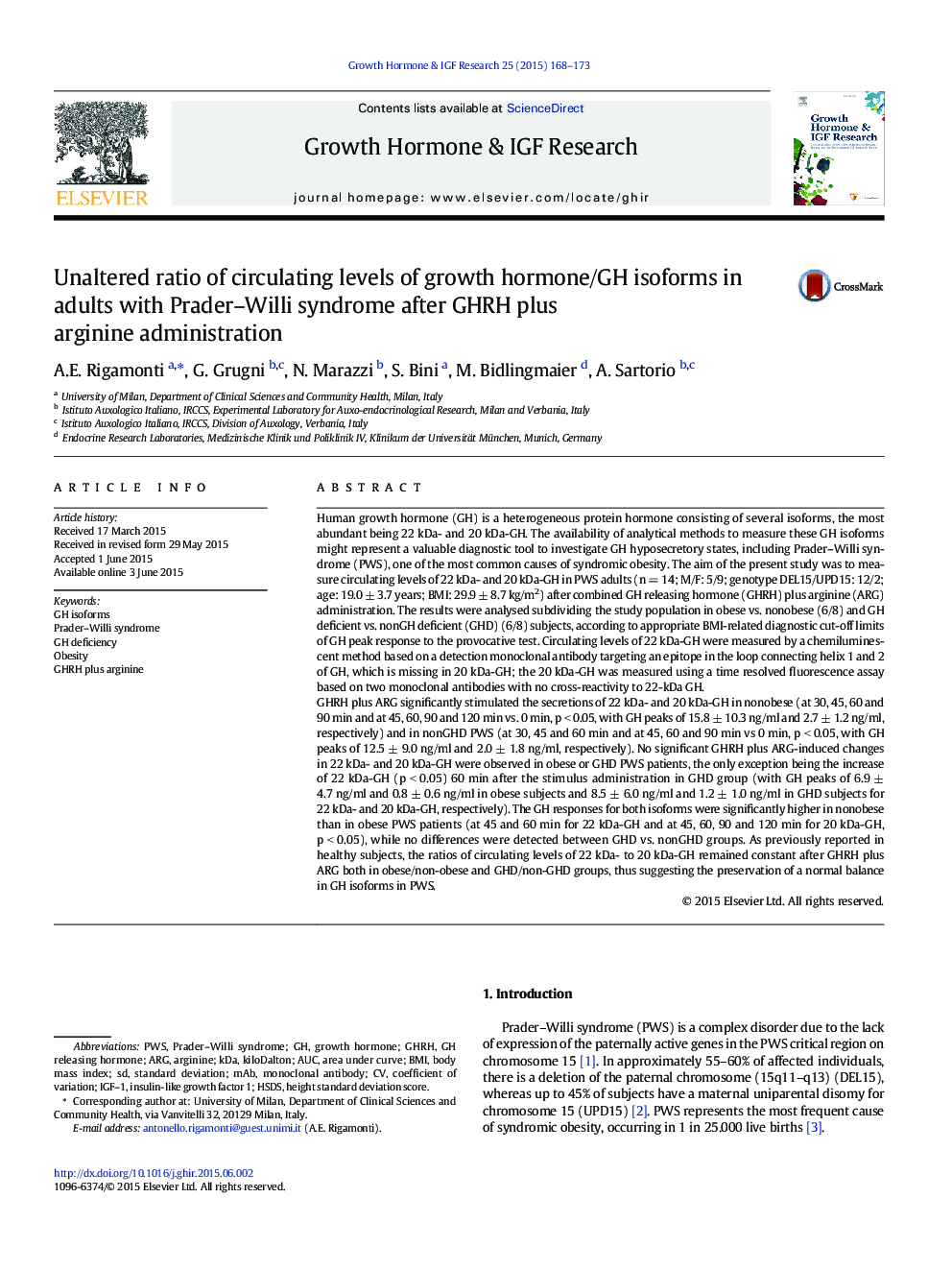| Article ID | Journal | Published Year | Pages | File Type |
|---|---|---|---|---|
| 2802547 | Growth Hormone & IGF Research | 2015 | 6 Pages |
•The origin of GHD in PWS is unknown.•So far, no one has considered the importance of evaluating GH isoforms in PWS.•This study demonstrates the preservation of a normal balance in GH isoforms after administration of GHRH plus arginine in PWS adults.•These preliminary results seem to exclude an alteration in generation of GH isoforms as biochemical mechanism of GHD in PWS.
Human growth hormone (GH) is a heterogeneous protein hormone consisting of several isoforms, the most abundant being 22 kDa- and 20 kDa-GH. The availability of analytical methods to measure these GH isoforms might represent a valuable diagnostic tool to investigate GH hyposecretory states, including Prader–Willi syndrome (PWS), one of the most common causes of syndromic obesity. The aim of the present study was to measure circulating levels of 22 kDa- and 20 kDa-GH in PWS adults (n = 14; M/F: 5/9; genotype DEL15/UPD15: 12/2; age: 19.0 ± 3.7 years; BMI: 29.9 ± 8.7 kg/m2) after combined GH releasing hormone (GHRH) plus arginine (ARG) administration. The results were analysed subdividing the study population in obese vs. nonobese (6/8) and GH deficient vs. nonGH deficient (GHD) (6/8) subjects, according to appropriate BMI-related diagnostic cut-off limits of GH peak response to the provocative test. Circulating levels of 22 kDa-GH were measured by a chemiluminescent method based on a detection monoclonal antibody targeting an epitope in the loop connecting helix 1 and 2 of GH, which is missing in 20 kDa-GH; the 20 kDa-GH was measured using a time resolved fluorescence assay based on two monoclonal antibodies with no cross-reactivity to 22-kDa GH.GHRH plus ARG significantly stimulated the secretions of 22 kDa- and 20 kDa-GH in nonobese (at 30, 45, 60 and 90 min and at 45, 60, 90 and 120 min vs. 0 min, p < 0.05, with GH peaks of 15.8 ± 10.3 ng/ml and 2.7 ± 1.2 ng/ml, respectively) and in nonGHD PWS (at 30, 45 and 60 min and at 45, 60 and 90 min vs 0 min, p < 0.05, with GH peaks of 12.5 ± 9.0 ng/ml and 2.0 ± 1.8 ng/ml, respectively). No significant GHRH plus ARG-induced changes in 22 kDa- and 20 kDa-GH were observed in obese or GHD PWS patients, the only exception being the increase of 22 kDa-GH (p < 0.05) 60 min after the stimulus administration in GHD group (with GH peaks of 6.9 ± 4.7 ng/ml and 0.8 ± 0.6 ng/ml in obese subjects and 8.5 ± 6.0 ng/ml and 1.2 ± 1.0 ng/ml in GHD subjects for 22 kDa- and 20 kDa-GH, respectively). The GH responses for both isoforms were significantly higher in nonobese than in obese PWS patients (at 45 and 60 min for 22 kDa-GH and at 45, 60, 90 and 120 min for 20 kDa-GH, p < 0.05), while no differences were detected between GHD vs. nonGHD groups. As previously reported in healthy subjects, the ratios of circulating levels of 22 kDa- to 20 kDa-GH remained constant after GHRH plus ARG both in obese/non-obese and GHD/non-GHD groups, thus suggesting the preservation of a normal balance in GH isoforms in PWS.
